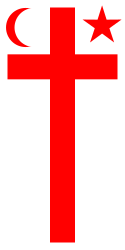This article has multiple issues. Please help improve it or discuss these issues on the talk page. (Learn how and when to remove these messages)
|
Mi'kma'ki | |
|---|---|
| Pre-contact–1867 (as a State) | |
|
Flag | |
 Seven Districts of Mi'kma'ki excluding Taqamkuk | |
| Status | Confederated districts of Wabanaki |
| Capital | Mniku, Unama'kik |
| Common languages | Mi'kmawi'simk |
| Demonym(s) | Mi'kmaq |
| Government | Sante'Mawio'mi / Mi'kmawey Mawio'mi |
| Kji Sagamaw | |
• unknown-1611 | Henri Membertou |
• 1792-1818 | Francis Peck |
• 1818-1842 | Michael Tooma |
• 1842-1869 | Frank Tooma Jr. |
| Sagamaw | |
| Putus | |
| History | |
• Established | Pre-contact |
• Contact with John Cabot[1] | 1497 |
• Exclusion from the Treaty of Utrecht | 1713 |
• First treaty with Great Britain after the Anglo–Wabanaki War | 1725 |
• Indian Act, 1876 | 1867 (as a State) |
| Population | |
• pre-1500 | 35,000−75,000[2] |
• 1500 | 4,500 |
• 1750 | 3,000 |
• 1900 | 4,000 |
• 2016 | 58,763[3] |
| Currency | Wabanaki Wampum |
| Today part of | Canada |
| Person | L'nu |
|---|---|
| People | Lnu'k (Mi'kmaq) |
| Language | Mi'kmawi'simk |
| Country | Mi'kma'ki Wabanaki |
Mi'kma'ki or Mi'gma'gi is composed of the traditional and current territories, or country, of the Mi'kmaq people, in what is now Nova Scotia, New Brunswick and eastern Quebec, Canada. It is shared by an inter-Nation forum among Mi'kmaq First Nations and is divided into seven geographical and traditional districts with Taqamkuk being separately represented as an eighth district, formerly joined with Unama'ki (Cape Breton). Mi'kma'ki and the Mi'kmaw Nation are one of the confederated entities within the Wabanaki Confederacy.

